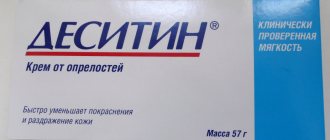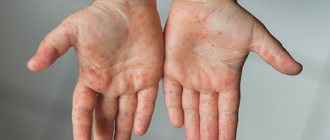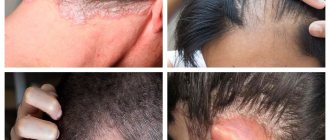Classification of the disease
There are four main types of miliaria, which differ in the nature of the rash, the duration of development and the severity of symptoms:
- Crystalline. It is accompanied by the development of a blistering rash, which most often appears on the head, behind the ears, and on the neck. Other localization of rashes is also possible. 2-3 days after the appearance, the blisters dry out and begin to peel off. Since irritation is not accompanied by inflammation or infection, the crystalline form is the simplest and most harmless.
- Red. A more complex type, in which sweat acts on the skin for a longer time and, accordingly, causes more severe irritation. A rash in the form of small inflamed tubercles provokes slight swelling and is accompanied by itching, burning, and discomfort. Lasts about two weeks.
- Miliaria alba, or vesiculopustulosis. With this type, blisters with a whitish or yellowish filling appear on the skin. When the bubble bursts, it leaves behind a light coating. The presence of color in the bubbly fluid indicates that the rash is accompanied by an infection, often staphylococcal.
- Deep. In most cases, prickly heat causes only superficial damage to the skin. With a deep form of pathology, the deep layers of the skin are affected. The disease is accompanied by blisters filled with light contents, which resolve or burst spontaneously.
How to make an appointment with a dermatologist
To make an appointment with a pediatrician or dermatologist, you can call us at the contact number or use the online form where you can select a specialist and an appointment time. We work all days, including weekends and holidays. JSC "Medicine" (clinic of academician Roitberg) is located in the Central Administrative District, near the Mayakovskaya, Tverskaya, Chekhovskaya, Belorusskaya and Novoslobodskaya metro stations. In addition, you can use our service to call a doctor at home. This will be convenient if the child has a serious general condition or you suspect the presence of a contagious disease.
Symptoms
The main and most obvious symptom of the pathology is a rash. Most often, rashes appear on the head, chest, back, groin, armpits, and buttocks. The rash appears as scattered blisters with clear, white or yellow contents, or as small grains with an inflammatory outline.
During the day, the rash may intensify or decrease, and the severity of its manifestation depends on changes in temperature and care for the baby’s skin. In some cases, the child does not show concern, but sometimes may experience itching, pain and demonstrate discomfort with whims, unstable sleep, and lack of appetite.
In mild forms of the disease, other symptoms may not occur. But in more advanced cases, which are accompanied by complications and infection, clinical manifestations may be supplemented by:
- elevated temperature up to 38 degrees;
- the appearance of light plaque, ulcers, ulcers;
- the formation of weeping cracks with an unpleasant odor;
- general deterioration of condition.
When assessing symptoms, it is important to prevent the development of advanced forms of prickly heat and consult a doctor promptly, without waiting for complications to develop. Source: Skin care for a newborn. Solntseva O.A. Medical Council, 2014. p. 35-39.
On the legs and arms
Blisters in a child’s extremities occur due to insufficient hygiene. Even microcracks can become a “gateway” for infection, which provokes local inflammation. If the blisters resemble hives, then this is an allergy, which can be provoked by:
- food products;
- contact with synthetic clothing;
- medications;
- dust;
- freezing;
- Pets.
In this case, blisters may appear on the palms and soles of the feet. They are accompanied by other allergic symptoms. This can be severe itching, watery eyes, sneezing, sore throat, etc. There are practically no diseases that could cause blisters of this localization, but it is still worth visiting a doctor with your child.
Causes
Most often, parents who do not adhere to the basic rules of caring for the child turn to doctors with complaints about heat rash in their baby: they bathe him with soap every day, wrap him up excessively without taking into account the real ambient temperature. Children with skin allergies, diabetes mellitus, rickets, seborrheic dermatitis or frequent diarrhea are also at risk. Chubby, overweight and bottle-fed babies are especially at risk of developing rashes.
Among other reasons for the development of prickly heat in children are:
- non-compliance with normal temperature conditions;
- too hot, tight clothes or shoes that do not allow air to pass through and do not create natural ventilation;
- excessive use of skin cosmetics that disrupt the acid balance and cause increased sensitivity (soaps, baby creams, oils, etc.);
- rare change of diapers or their poor quality, lack of care;
- viral diseases that are accompanied by fever.
On fingers and palms
Blisters on the palms of a child are one of the common manifestations of eczema, which develops against the background of blockage of the sweat glands. This disease is called dyshidrosis. Blisters on the palms of a child also occur with scarlet fever. They usually form after parents have discovered other symptoms, so the rash no longer surprises them.
Also, blisters on a child’s toes occur due to:
- allergies;
- dermatitis;
- insect bite;
- lack of vitamins.
How to distinguish heat rash in a child from allergies and other diseases
When a rash appears on the skin, the most difficult thing for parents is to distinguish prickly heat from other diseases: allergies, chicken pox, measles, etc.
First, you should examine the location of the rash. In the first case, the rashes are located in hard-to-reach places: in the area under the diaper, in the folds of the skin, in the hairline. In this case, the rash almost never appears on open areas of the skin that are well ventilated. But if the rash appears on the face, open parts of the arms and legs, most likely it is an allergy.
A simple home test will also help make a differential diagnosis. You just need to undress the baby and leave him without clothes or a diaper for several hours. If the rash appears as a result of prickly heat, during this time it will decrease and become paler. If it is an allergy, no changes will occur to it.
Additional symptoms will help distinguish the disease from measles, chickenpox and other viral pathologies. With infectious diseases, the temperature always rises, intoxication appears, and the rash quickly spreads throughout the body. In turn, the main symptom of prickly heat is just a rash.
On the feet and heels
Blisters on a child’s foot often occur due to a fungal disease. Heel spots can be a result of wearing uncomfortable shoes. These are common calluses that occur immediately after rubbing the skin. Because of them, the child’s gait is disrupted, since it is painful for him to walk in uncomfortable shoes.
Another reason is again an allergic reaction, especially if there was contact with an allergen at the site of the rash. Another cause of blisters is autoimmune arthritis, which is characterized by joint stiffness and pain.
Diagnostics
You should not self-medicate or try to diagnose your child yourself. Before you begin to treat prickly heat in a child, when the first rash appears, you should contact a pediatric dermatologist or pediatrician. The specialist will conduct an examination and distinguish the pathology from other diseases that are accompanied by a skin rash. For an experienced pediatric specialist, this is not difficult even with an initial visual examination.
In some cases, additional examination is necessary for a comprehensive diagnosis. The doctor may prescribe scraping for pathogenic fungal infections, as well as bacterial culture for microflora.
Types of rash
Rashes on the abdomen of a child are quite variable in nature and etiology (origin).
Pediatricians distinguish the following types of rash:
- Spots are areas with clear boundaries on the surface of the skin of a discolored color (spots do not protrude above the skin and cannot be felt during palpation);
- Papules are tubercles up to 5 mm in diameter, without an internal cavity and protruding above the skin;
- Plaques are formations raised above the surface of the epidermis, significant in area, having a flattened shape;
- Vesicles are formations with liquid contents;
- Bubbles are vesicles more than 5 mm in diameter;
- Pustules are cavities limited by the membrane with purulent contents.
Some diseases are also characterized by peeling of the skin. Any changes in the appearance of the skin surface are a signal that not everything is in order in the baby’s body. Of course, not all diseases accompanied by a rash require special therapy, but such signs should not be ignored in any case.
Treatment
The main method that allows you to remove rashes and cure skin pathologies is hygienic care. It is important to change the diaper immediately after a bowel movement and every three hours, washing the baby with running water. Between shifts you need to give air baths and leave the baby without clothes for a few minutes. At the same time, it is necessary to abandon synthetic clothing and low-quality children's cosmetics.
Bathing is carried out in water with a decoction of medicinal herbs. You can add chamomile, yarrow, and string. After bathing the child, dry thoroughly and powder the skin with powder.
In some cases, the doctor also prescribes treatment of rashes with drying antiseptics (“Furacilin”, “Chlorphilipt”), and creams containing panthenol (“Bepanten”, “Dexpanthenol”). White, red and deep miliaria are treated with antifungal and antibacterial ointments. However, it is not recommended to use any medications without prior consultation with a doctor. Source: Modern dermatological and cosmetic products for caring for the skin of children. Kotlukov V.K., Kuzmenko L.G., Antipova N.V. Medical Council, 2013. p. 8-12.
Doctors recommend setting the air temperature in the nursery at 20-22 degrees and monitoring the humidity, which should not exceed 50-70%. A good solution would be to purchase an air humidifier that will help create the right microclimate. These simple steps can help you get rid of the conditions that increase your risk of developing heat rash.
Prevention
Effective prevention consists of proper and thorough hygienic care of the child: regular bathing, frequent changing of diapers or diapers. During the hot season, you can bathe your baby up to 2-4 times a day, but it is important not to use soap, oils, lotions and other products with each water procedure that can disrupt the acid balance and clog the glands.
It is also important to select clothes from natural, breathable fabrics and avoid synthetic and semi-synthetic fabrics that do not ensure normal evaporation of sweat. You need to dress your baby appropriately for the weather and not wrap him up in a warm blanket on a summer night. Source: Skin care for infants. Prevention of diaper dermatitis. Starostina L.S. Medical Council, 2022. p. 41-49.
Sources:
- Skin care for infants. Prevention of diaper dermatitis. Starostina L.S. Medical Council, 2022. p. 41-49
- Newborn skin care. Solntseva O.A. Medical Council, 2014. p. 35-39
- Modern dermatological and cosmetic products for the care of children's skin. Kotlukov V.K., Kuzmenko L.G., Antipova N.V. Medical Council, 2013. p. 8-12
Date of publication: 10/20/2017
The information in this article is provided for reference purposes and does not replace advice from a qualified professional. Don't self-medicate! At the first signs of illness, you should consult a doctor.










